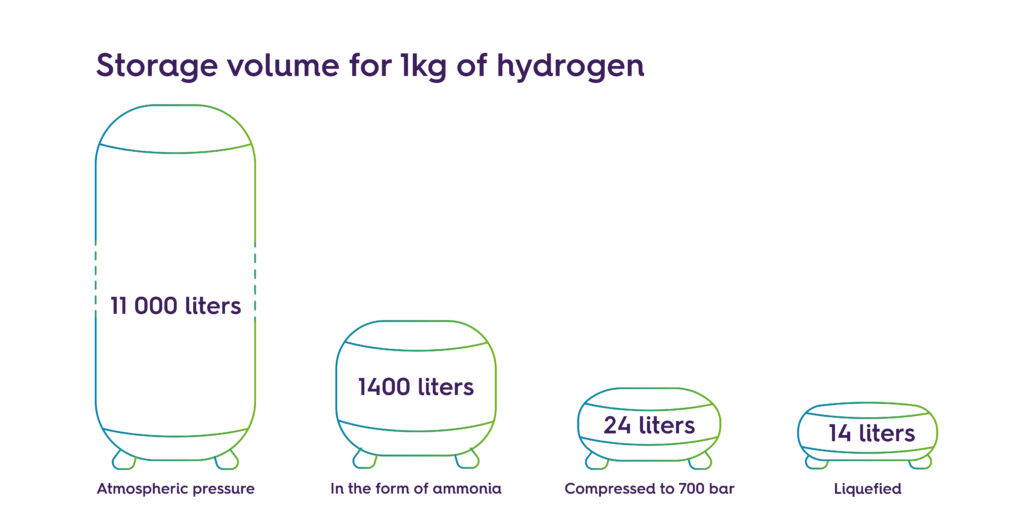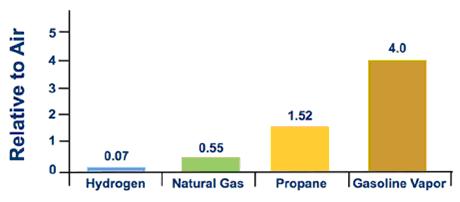Overcoming the Challenge of Hydrogen Storage
08 June 2023 – by Eric Koons Comments (0)
Hydrogen is a promising alternative fuel that can significantly reduce greenhouse gas emissions from several key industries. However, one of the largest challenges of using hydrogen as an energy carrier is its storage and transport.
Hydrogen Storage Tanks
Due to its low density, hydrogen must be compressed or liquefied for storage and transportation. This requires specialised hydrogen storage tanks and transportation vessels, which add to the overall cost of the infrastructure. Moreover, hydrogen is highly flammable and requires strict safety protocols to ensure safe handling and storage.
Depending on the intended use of hydrogen, the requirements for storage of hydrogen may vary, ranging from high-pressure gaseous storage to cryogenic liquid storage. Therefore, developing efficient and safe hydrogen storage technologies is crucial for the widespread adoption of green hydrogen.
Hydrogen Storage Methods – How Is Hydrogen Stored?
There are three main methods of storing hydrogen: liquid, gas and solid.
1. Liquid Hydrogen Storage
Liquid hydrogen storage involves cooling gaseous hydrogen to extremely low temperatures (-253°C) to convert it into a liquid state. This method requires specialised equipment and infrastructure and is costly. However, liquid hydrogen has a high energy density. The downside is the risk of hydrogen leakage and the need for constant cooling.

2. Compressed Hydrogen Storage
Hydrogen gas storage involves compressing hydrogen at high pressures (350-700 bar) into hydrogen energy storage tanks. The method of compressed hydrogen is less expensive than liquid hydrogen storage and is viable for stationary and mobile applications. However, compressed gas storage requires heavy and bulky tanks, limiting storage quantity.
3. Solid-State Stored Hydrogen
Solid-state storage involves storing hydrogen in materials that can absorb and release it. This method can offer high energy density, low pressure and safe storage capabilities. However, solid-state storage technology is still in its early stages of development and requires further research and development to become commercially viable.
Why Is Storing Hydrogen a Problem?
Hydrogen is a relatively low-density gas and requires high pressure or very low temperatures to achieve a reasonable energy density. This poses difficulties for infrastructure development.
More so than oil or gas, hydrogen is highly flammable and requires special handling and storage. It has a broad flammability range and low energy ignition requirements compared to most other fossil fuels. For example, gasoline requires 80% more energy to combust than hydrogen.

In addition, it is difficult to store large quantities of hydrogen due to its low energy density. This means it requires a large space to keep the quantities needed for industrial applications. Another consideration is its small molecule size, making it prone to leaking. Small cracks in storage containers that would typically not be an issue for other fossil fuels are a concern for hydrogen. Hydrogen molecules are less than 2% the size of gasoline vapour and 13% the size of natural gas.
Despite these challenges, there is a growing interest in developing hydrogen storage and transportation infrastructure to support the transition to a low-carbon economy.
Converting Natural Gas Infrastructure for Hydrogen
One option for developing hydrogen infrastructure is repurposing existing natural gas infrastructure to accommodate hydrogen storage and distribution. However, natural gas pipes and storage facilities are not designed to handle the unique properties of hydrogen.
Retrofitting old infrastructure can be expensive and time-consuming, requiring significant investment in research and development. With the right technology and regulatory frameworks, converting ageing natural gas infrastructure to store hydrogen could help accelerate the transition towards a carbon-free future.
Hydrogen Storage Is Critical for the Energy Transition
Storage is critical for the success of green hydrogen in the global energy transition. According to the World Economic Forum, making green hydrogen viable is necessary for the success of net-zero goals.
While batteries are a popular solution for energy storage, they are expensive and lack the necessary efficiency. On the other hand, green hydrogen can store large amounts of energy for an extended period, making it a more viable option.

To overcome the challenges associated with hydrogen, efforts are underway to develop innovative storage solutions that improve the efficiency and safety of hydrogen storage. This includes modelling storage options, testing new large-scale storage and production facilities and researching options for solid-state storage.
The Green Hydrogen Market: Good For Investors and Demand
Green hydrogen is an exciting, fast-developing and critical aspect of the green energy transition. Pilot projects, initiatives and large-scale investments are all growing in pace. Over 680 large-scale green hydrogen projects have been announced, totalling USD 240 billion in investments.
This is supported by an expected increase in demand, which some estimates put at an almost 55% compound annual growth rate to the total market size of over USD 300 billion by 2033. Not only is green hydrogen critical for countries striving to meet their climate goals, but it is a significant market opportunity. The world needs this scale of investment to develop the effective storage technology crucial for the success of green hydrogen.
by Eric Koons
Eric is a passionate environmental advocate that believes renewable energy is a key piece in meeting the world’s growing energy demands. He received an environmental science degree from the University of California and has worked to promote environmentally and socially sustainable practices since. Eric’s expertise extends across the environmental field, yet he maintains a strong focus on renewable energy. His work has been featured by leading environmental organizations, such as World Resources Institute and Hitachi ABB Power Grids.
Read more